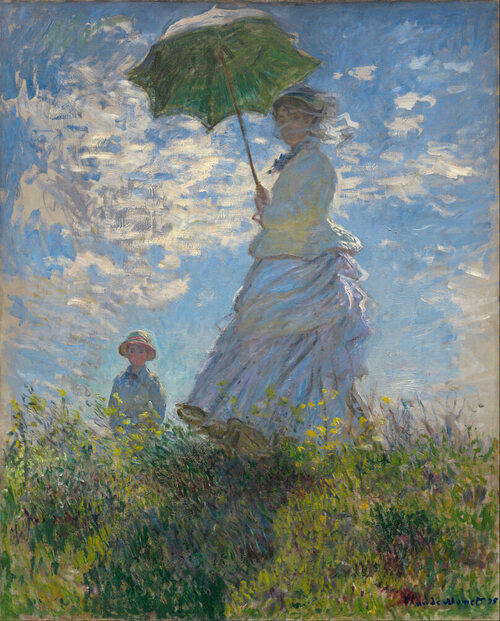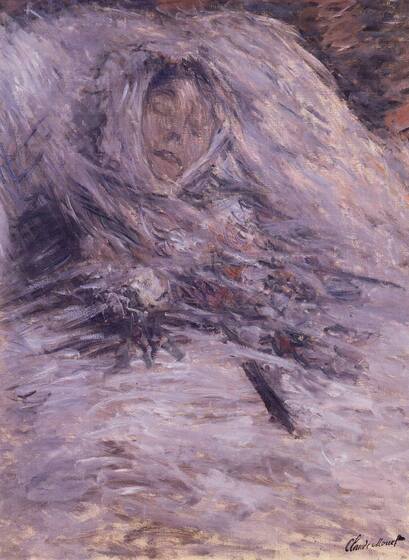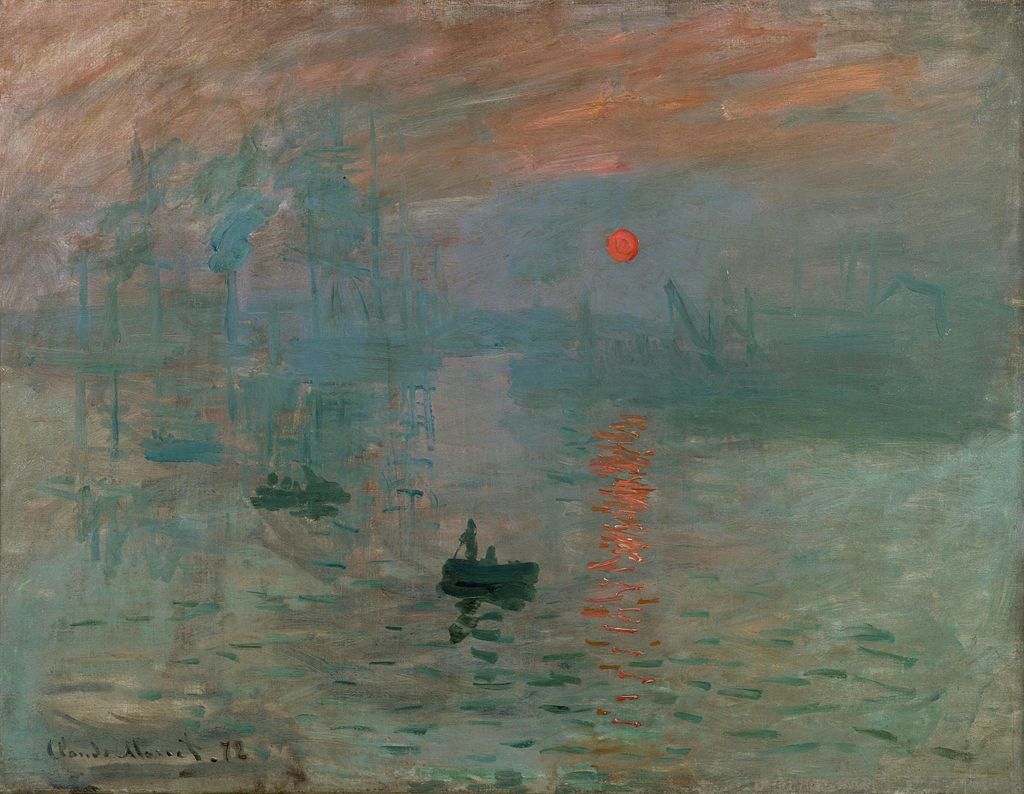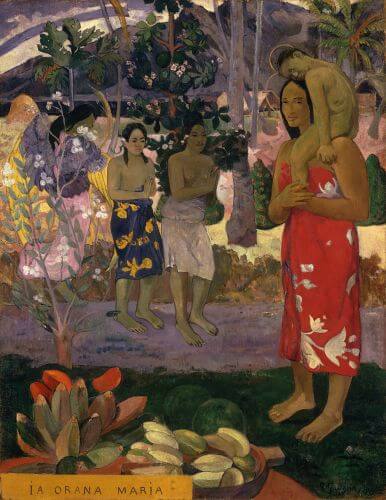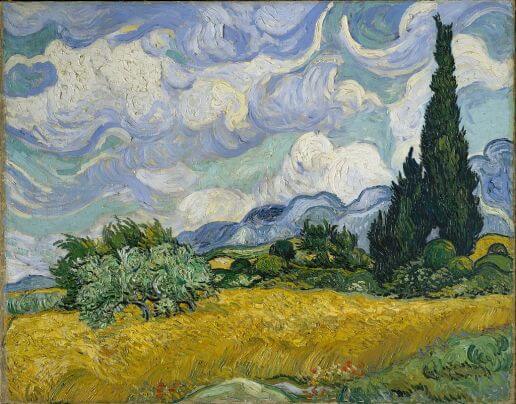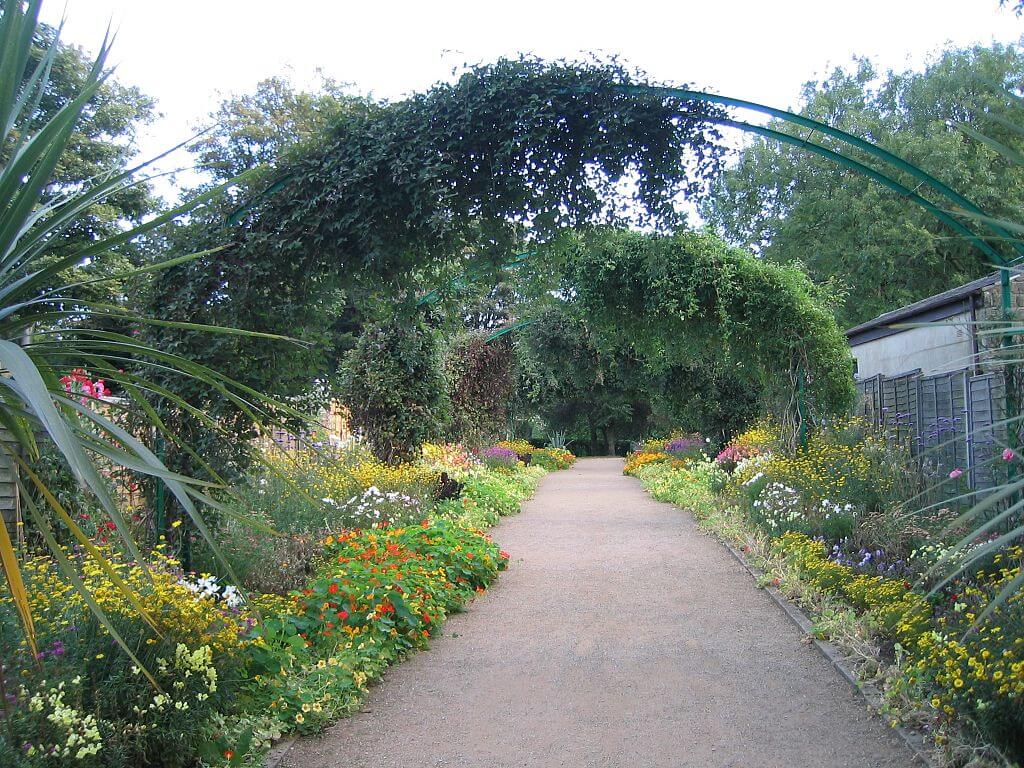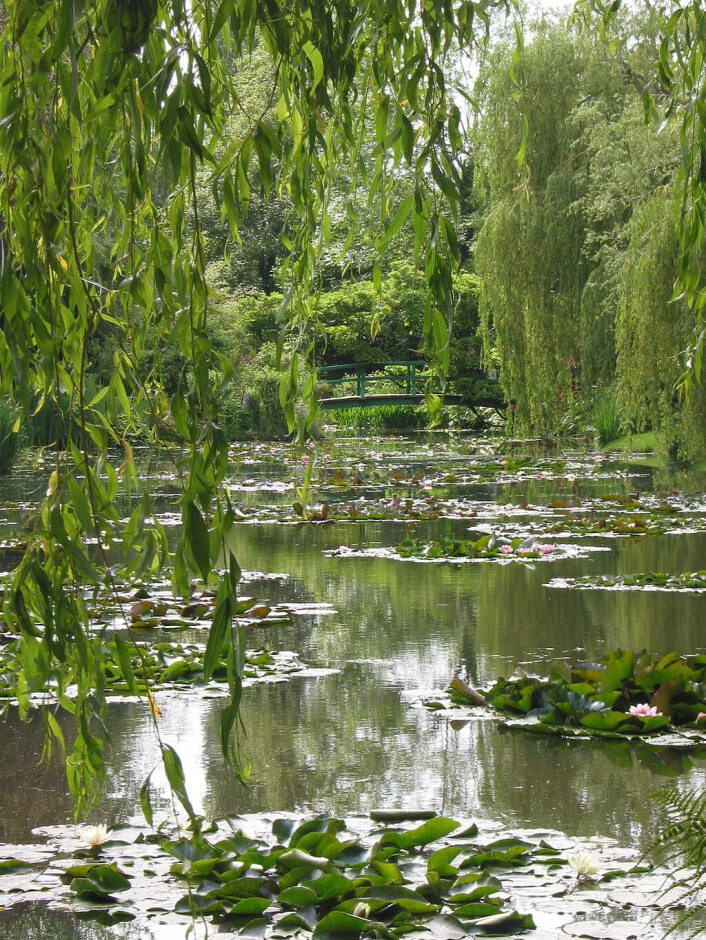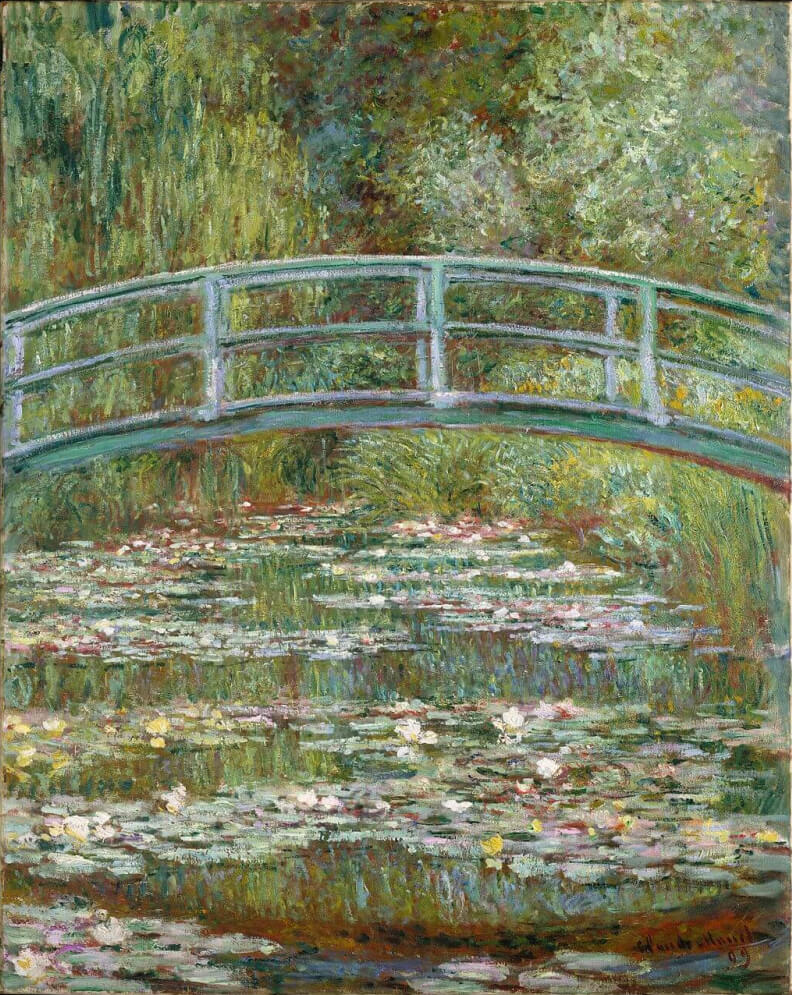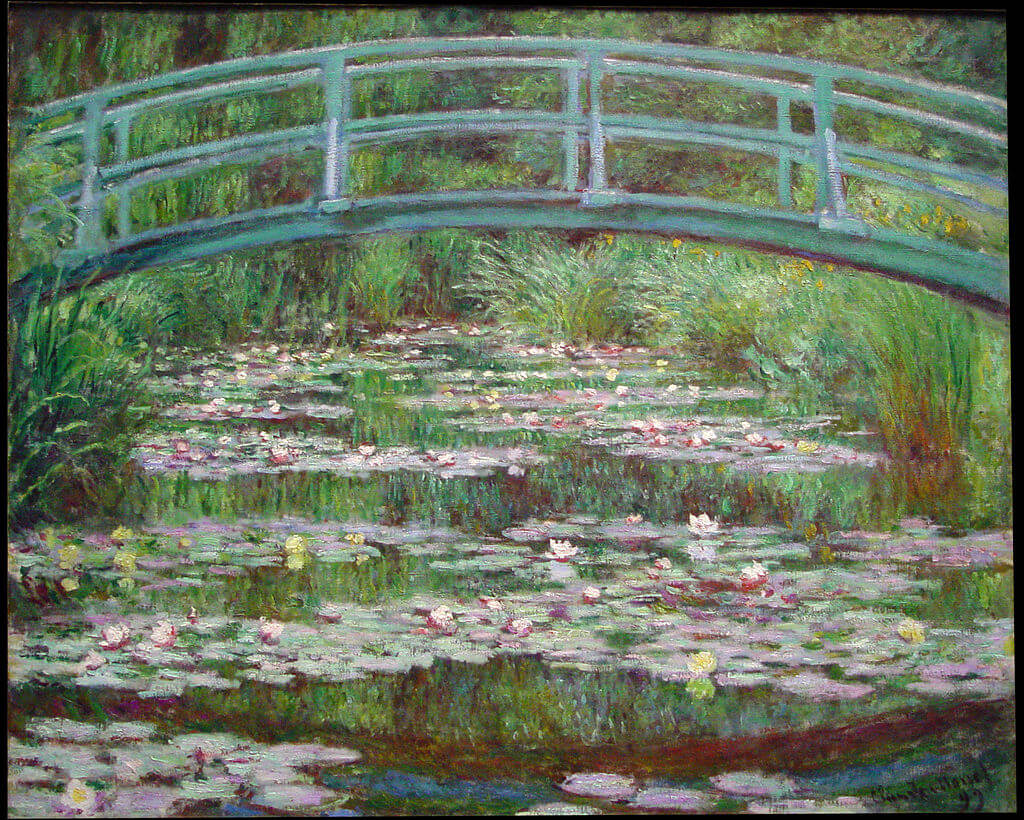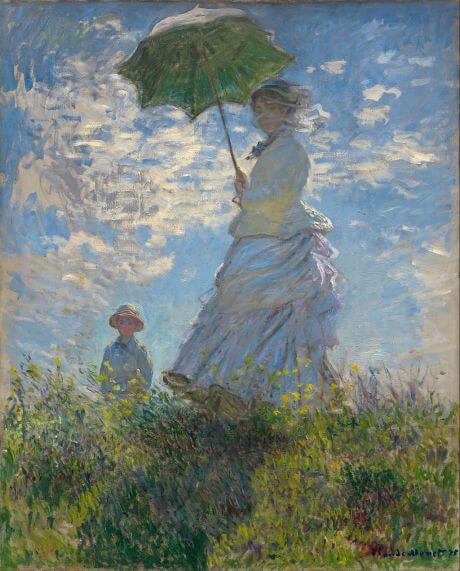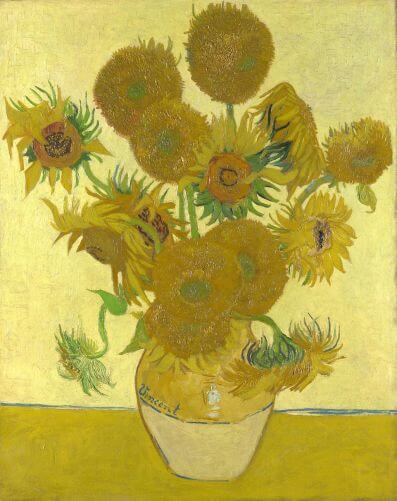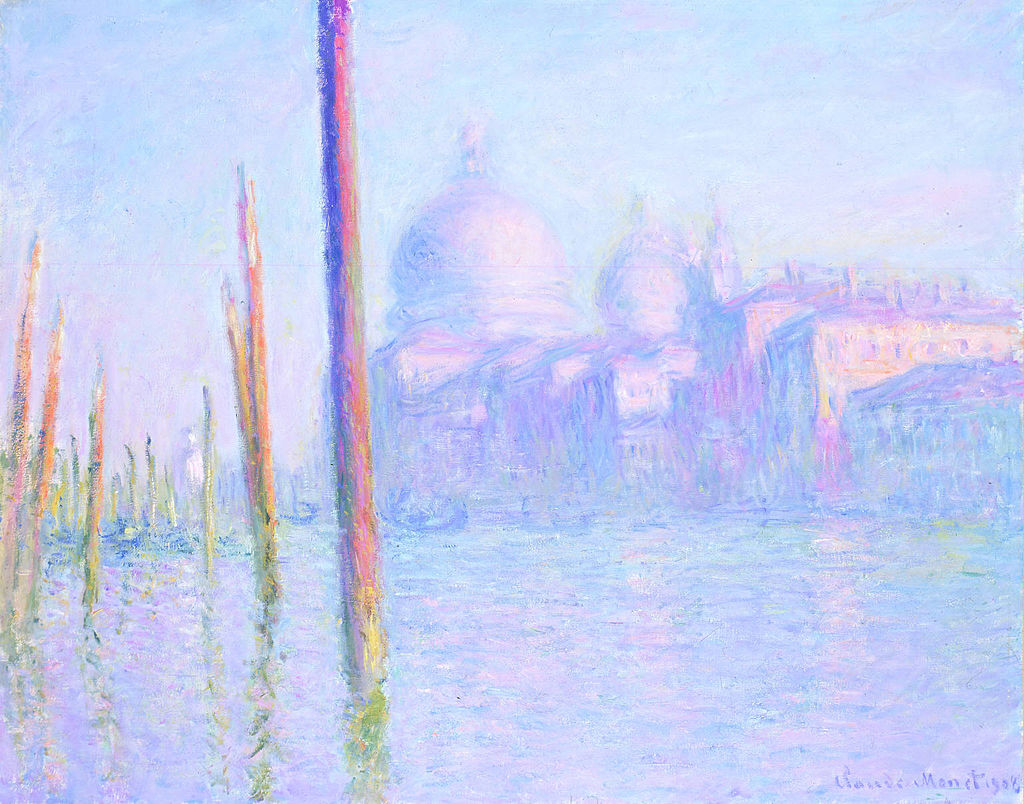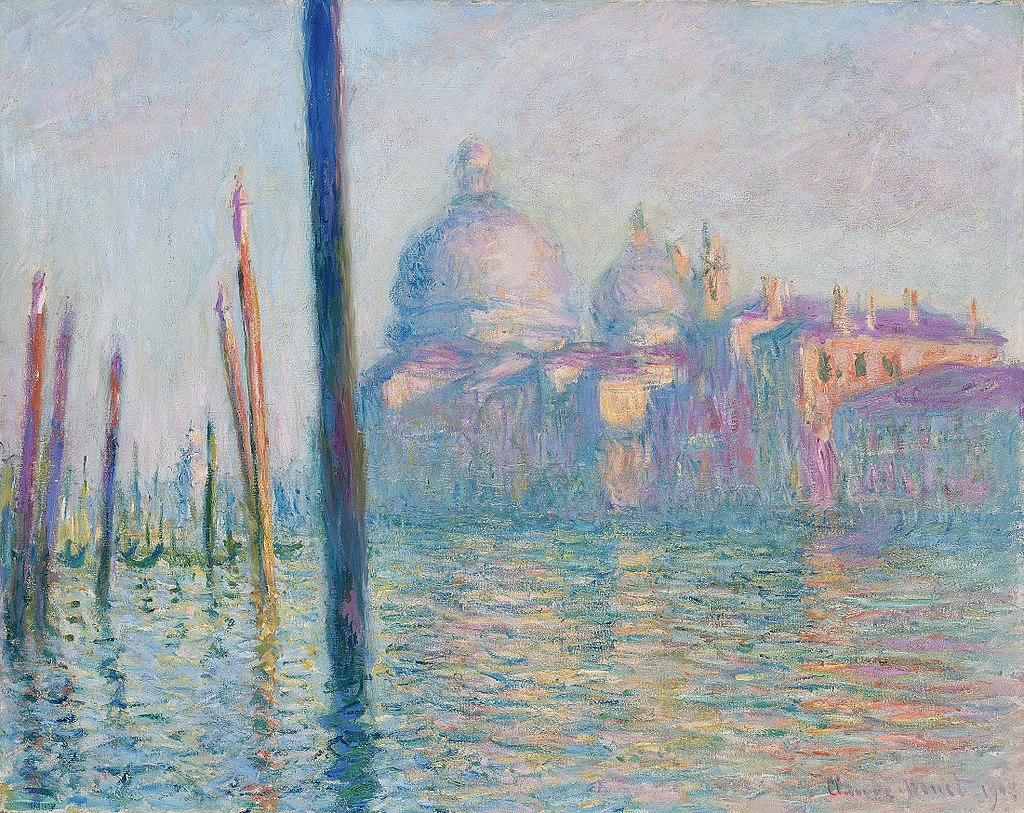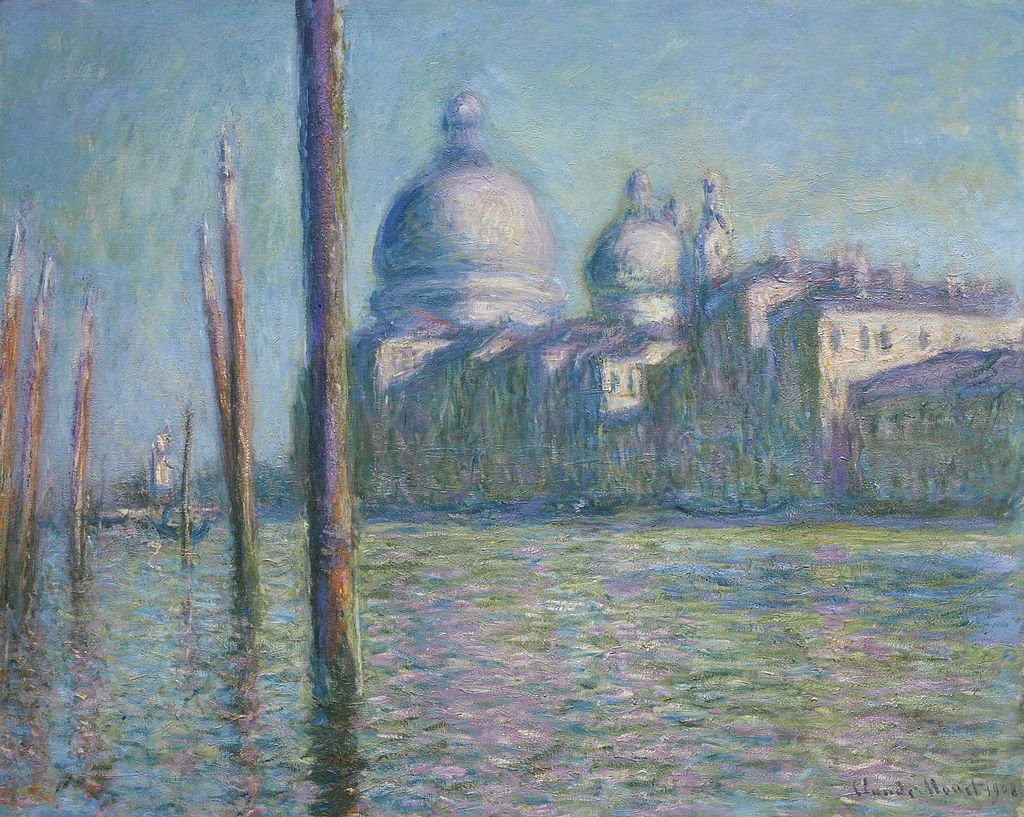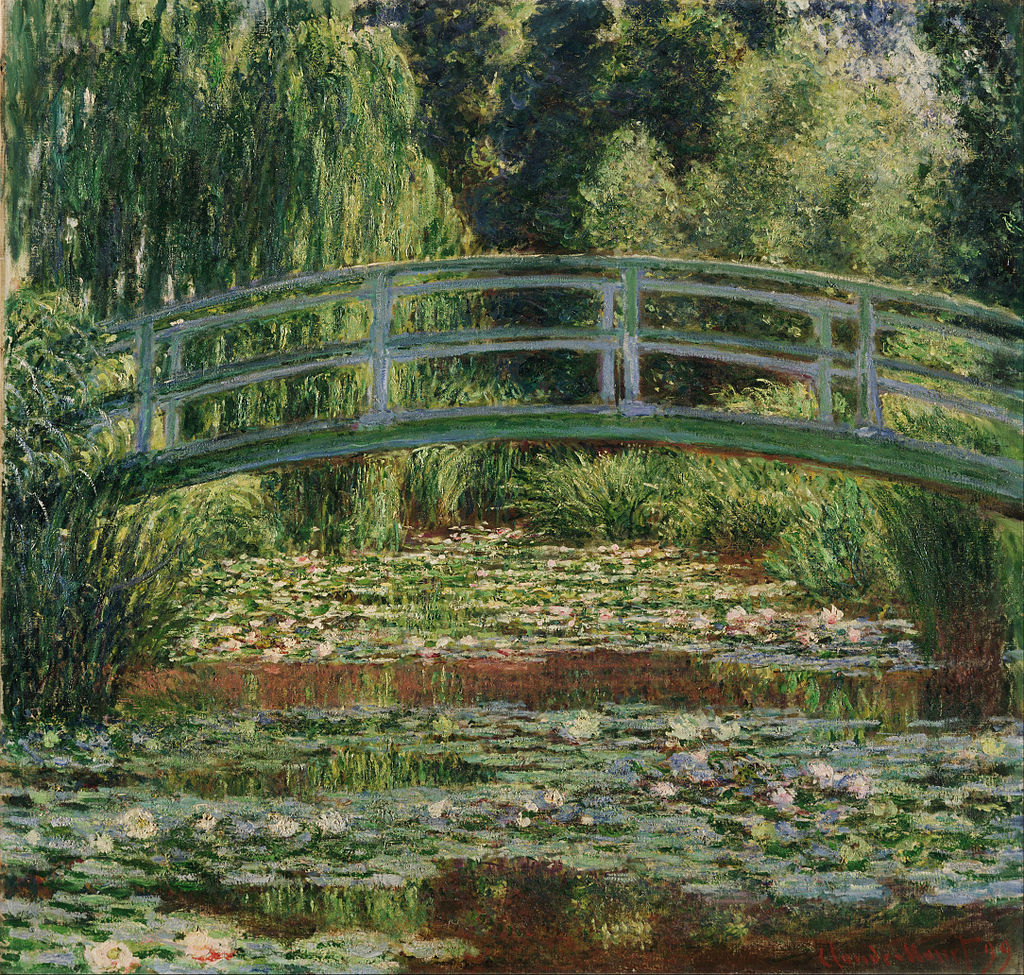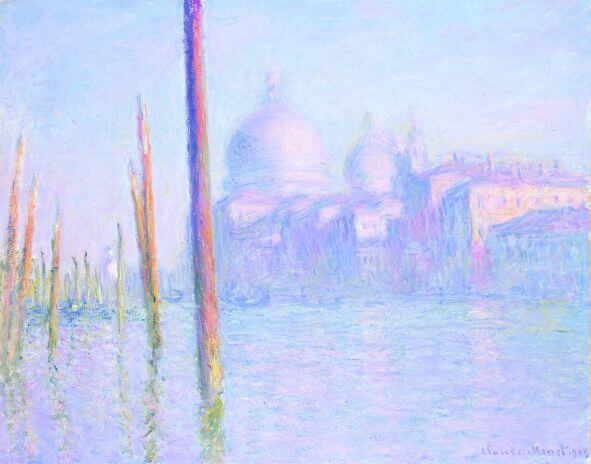|
Where? Gallery 85 of the National Gallery of Art
When? 1875 What do you see? Claude Monet painted his wife Camille and their eldest son Jean who are out for a stroll on a windy and sunny day. Monet captures a brief moment during some quality time with his family. Madame Monet and her son stand on a small hill given the position of Jean, and they are looking towards the painter Claude Monet. In the foreground is a field with yellow wildflowers and grass. Madame Monet holds a green and blue parasol in both hands to protect herself from the sun, while her son is wearing a hat. Madame Monet wears a light-colored dress and jacket on top of it. Jean is standing with his hands in his pocket and seems to be wearing a light shirt and a blue tie. Based on the shadow of Madame Monet in the foreground, we know that the sunlight is coming from the top right. You can clearly see the effects of the strong wind by the veil of Madame Monet which is blown around her face, the shape of her dress, and the movement of the wildflowers in the foreground. Monet integrates his wife and son with the environment. The colors of the blue sky and the white clouds come back in the top of the parasol and the clothing of Madame Monet and her son. However, notice also the subtle hints of pink and yellow in the dress of Madame Monet and the usage of red and green in the hat of her son. Backstory: This painting is also referred to ‘The Stroll’ and Monet created this painting in several hours. The Monet family lived at this time in Argenteuil, which is now a suburb of Paris, but at that time it was a rural village northwest of Paris. The son of Claude Monet is seven years old at the time of the painting and Madame Monet 28. In 1965, the painting was bought by the American philanthropist Paul Mellon and his wife, Bunny Mellon. They donated the painting in 1983 to the National Gallery of Art. Symbolism: The parasol, the veil, and the dress of Madame Monet are symbols of status, even though the Monet family was not rich at all during that moment. The parasol also symbolizes protection. The countryside in this painting contrasts with the cities and industry among which Monet grew up and which he did not like. Finally, the light color of the dress refers to the purity of Madame Monet. Who is Monet? Claude Monet (1840-1926) was born in Paris. He married to Camille Doncieoux in 1870. Their first son, Jean, was born in 1867. Claude Monet adored Camille and used her as a model in many of his paintings. Unfortunately, she died in 1879 at the age of 32. In the Musée d’Orsay, you can find a painting by Monet of his wife on her deathbed. In 1892, he married Alice Hoschedé. The daughter of Alice from her earlier marriage, Blanche, married to the Monet’s son Jean who is depicted in this painting. Monet is an Impressionist painter and primarily applied this style during his career to paint landscapes. In 1883, he moved to Giverny, about 45 miles northwest of Paris, where he developed a large landscaping project including several lily ponds, which are the source for many of his famous painting of the lily ponds.
What is Impressionism? The Impressionist art style started in the 1860s in France. The style is characterized by small, but visible brush strokes. For example, if you study this painting of Monet closely, you can clearly see the brush strokes. This is best illustrated by the white brush strokes in the sky on the left side of the painting.
Impressionism was initially developed by painters such as Monet and Renoir and later also adopted by painters like Pissarro and Cézanne. Besides the type of brush strokes, these painters also focused on simple subjects for their art (scenes from daily life), the focus on the accurate depiction of light in the paintings, and by including a sense of movement in the painting. The Impressionist style has been named after a painting of Monet in 1872, entitled Impression, Sunrise, which is now in the Musée Marmottan Monet in Paris. Impressionism was the basis for future styles such as Neo-Impressionism and Post-Impressionism. Two well-known Post-Impressionists are Gauguin and Van Gogh.
Fun fact: In 1876, Monet ‘sold’ this painting to the Romanian art collector and homeopath George de Bellio. This homeopath was the doctor of Madame Monet during her illnesses, and as the Monet family did not have much money, they usually paid him with some of Monet’s artworks. George de Bellio was a big fan of Impressionism and used similar arrangements with artists such as Manet, Pissarro, and Renoir.
The children of George de Bellio donated the collection of their father between 1957 and 1966 to the Musée Marmottan Monet, and this museum has, nowadays, the largest collection of Monet paintings.
4 Comments
Where? Gallery 161 of the Philadelphia Museum of Art
When? 1899 What do you see? A pond full of water lilies. The green leaves of the water lilies are resting on top of the water and are scattered across the pond. Many of the water lilies are blooming, and the large flowers stick out of the water. They are predominantly white, but Monet adds some hints of other colors, like blue, pink, red, and yellow, to depict the flowers. The pink and red tones are more visible in the water lilies in the back. Foliage surrounds the pond. A blue Japanese-style wooden footbridge crosses over the pond. In the background, a dense collection of trees covers the sky. On the left, you can see the hanging leaves of the willows. You can see the reflection of the water lilies, the plants, and the trees in the pond, but at places, you can also see the transparency of the water in the pond. Monet must have had several people that kept its pond very clean to be able to see all these reflections in the water. Backstory: In 1883, Monet moved to Giverny, about 45 miles Northwest of Paris. In 1893, he got the idea to buy a piece of land with a small pond next to his property. He expanded this pond and turned the land into a Japanese water garden full of bushes, flowers, trees, and water lilies. He also added a Japanese-style wooden bridge which you can see in this painting. Several years later, Monet started to paint the pond with the water lilies and the bridge and continued to do so for the last 27 years of his life. Monet chose to omit the sky and the edge of the water in the foreground to try to fully absorb the viewer in the view of the water lily pond.
The Water Lily Garden: Giverny Monet’s Garden is open to the public, and about 500,000 people visit the garden every year. It consists of the house of Monet and two parts of the garden. The first part is the flower garden which is full of common and rare varieties. Monet developed a love for gardening and was always on the lookout for rare flower species.
The second part of the garden is the Japanese-inspired water garden that you can see in this painting. His design of the water garden was inspired by prints of gardens in Japan that he collected (though Monet had never visited Japan). Monet was so inspired by this garden that he created about 250 paintings of it (though not all of them have survived as Monet destroyed some of them and others have been affected by fire). He painted the water lilies at different times of the day and at different times during the year, such that every painting looks a little bit different. For example, the Metropolitan Museum of Art exhibits the Bridge over a Pond of Water Lilies, and the National Gallery of Art shows The Japanese Footbridge. Other examples can be found in, amongst others, the National Gallery, the Musée d’Orsay, and the Pushkin Museum in Moscow.
Who is Monet? Oscar-Claude Monet (1840-1926) was born in Paris. He is considered to be one of the founders of impressionism. Together with artists like Cézanne, Degas, Pissarro, and Renoir, Monet set up several exhibitions in Paris in 1860 and 1870 to expose the public to this new style, including the painting Woman with a Parasol - Madame Monet and Her Son, which is now in the National Gallery of Art.
Monet was a very productive painter and his work has a unique style and subjects. For example, where many people associate sunflowers immediately with Van Gogh, water lilies are associated with Monet. Monet created gardens at all places where he lived, but the water lily pond was by far his favorite garden. He also traveled a lot through Europe to find nice landscapes which he used as an inspiration for his gardens and paintings.
Fun fact: Monet wanted to have exotic plants and water lilies in his garden, but the local community was against it as they were concerned that these exotic flowers would poison the water in Giverny. However, Monet proceeded anyway and imported flowers with the most beautiful colors from around the world. His water lilies came from Egypt and South America.
In 1912, Monet got diagnosed with cataracts in both eyes and his sight suffered because of that. He could not perceive colors in the same way anymore and that was reflected in his paintings. For example, instead of using predominantly blue, green, and white for the water lilies, he started to use more yellow and purple. As a result of this, Monet decided to paint more abstract paintings beginning in 1915.
Where? Gallery 19 of the Legion of Honor Museum
When? 1908 What do you see? A view down the Grand Canal in Venice under somewhat hazy conditions in the middle of the afternoon. On the left is a series of mooring poles were boats can park. At the end of the canal is the Santa Maria della Salute Church. The church has two large domes and a tower, but Monet is more interested in painting the effects of light and the water. Monet uses blue, pink, and purple tones for most of the painting. The church is painted in lighter tones, and some of these colors comes back in the reflection of the church in the water. Monet was so interested in the effects of light that the true colors of the church are not recognizable in this painting. Backstory: The Grand Canal is the major waterway that goes through the middle of Venice. Claude Monet painted this painting of the Grand Canal and the Santa Maria della Salute Church from a spot near the Palazzo Barbaro. This palazzo was owned by a Mary Young Hunter, a relative of the American Impressionist painter John Singer Sargent, who had introduced her to Monet’s wife. Over the years, several Impressionist painters, including Monet, were allowed to stay at this place and work on their paintings. Santa Maria della Salute: The Catholic Santa Maria della Salute Church in Venice is popularly known as the Salute. The church was dedicated to Our Lady of Health and was built to commemorate the end of a catastrophic outbreak of the plague in Venice in 1630. Its impressive dome is an iconic aspect of the skyline of Venice. Not only Monet was inspired by the sight of this church; also artists like Canaletto, Sargent, and Turner included this church in their works. Other versions: Monet painted six versions of The Grand Canal, Venice during this time in Venice. Monet wanted to paint the same view at the same time of the day, but capture the variations in the weather which would, in turn, lead to different light conditions. Thus, while the outline of the six paintings is the same, the light effects differ. The first picture below is the version in the Museum of Fine Arts in Boston. The second picture below is a version that is part of a private collection. One of the six versions was sold in 2015 for $35.6 million.
Who is Monet? Claude Monet was born in 1840 in Paris and died in 1926 in Giverny, about 45 miles West of Paris. He was one of the founders of Impressionism. At the beginning of his career, his works were not positively received by many people. But he continued to develop his Impressionist style. One of the paintings he created during this time was Woman with a Parasol - Madame Monet and Her Son in the National Gallery of Art.
Eventually, Monet became a very successful painter who was able to sell most of his works for good prices. With the money that he earned, he bought a house in Giverny where he created a beautiful large garden where he could spend much time painting in the outdoors. One of the paintings he created in his garden was The Japanese Footbridge and the Water Lily Pool, Giverny in the Philadelphia Museum of Art.
Fun fact: Claude Monet had always told his wife that Venice was too beautiful to paint. But when a friend of Monet’s wife presented them with the opportunity to visit the city and stay at her house with a beautiful view, they could not refuse. During his first week in Venice, Monet was still of the opinion that Venice was too beautiful to paint, but after that first week, he could no longer retain himself.
During his almost 2.5 months in Venice in the Fall of 1908, he painted a total of 37 works of Venice, including the six versions of The Grand Canal, Venice. He painted the first part of these works en plein air (outside) and completed the paintings in his studio in Giverny. While he immediately sold 28 of the 37 paintings to a dealer after he got back to France, it would take him three more years to complete the paintings.
Where? Gallery 252 of the Museum of Fine Arts
When? 1908 What do you see? A view down the Grand Canal in Venice in the middle of the afternoon. On the left is a series of mooring poles were boats can park. At the end of the canal is the Santa Maria della Salute Church. The church has two large domes and a tower, but Monet is more interested in painting the effects of light and the water. Monet uses red, orange, purple, and pink tones for the church, and he adds green tones to the water. In the green and blue water, we can see the reflections of the church and the adjoining buildings on the right. Backstory: The Grand Canal is the major waterway that goes through the middle of Venice. Claude Monet painted this painting of the Grand Canal and the Santa Maria della Salute Church from a spot near the Palazzo Barbaro. This palazzo was owned by a Mary Young Hunter, a relative of the American Impressionist painter John Singer Sargent, who had introduced her to Monet’s wife. Over the years, several Impressionist painters, including Monet, were allowed to stay at this place and work on their paintings. Santa Maria della Salute: The Catholic Santa Maria della Salute Church in Venice is popularly known as the Salute. The church was dedicated to Our Lady of Health and was built to commemorate the end of a catastrophic outbreak of the plague in Venice in 1630. Its impressive dome is an iconic aspect of the skyline of Venice. Not only Monet was inspired by the sight of this church; also artists like Canaletto, Sargent, and Turner included this church in their works. Other versions: Monet painted six versions of The Grand Canal, Venice during this time in Venice. Monet wanted to paint the same view at the same time of the day, but capture the variations in the weather which would, in turn, lead to different light conditions. Thus, while the outline of the six paintings is the same, the light effects differ. The first picture below is the version in the Legion of Honor Museum in San Francisco. The second picture below is a version that is part of a private collection. Another one of the six versions was sold in 2015 for $35.6 million.
Who is Monet? Claude Monet was born in 1840 in Paris and died in 1926 in Giverny, about 45 miles West of Paris. He was one of the founders of Impressionism. At the beginning of his career, his works were not positively received by many people. But he continued to develop his Impressionist style. One of the paintings he created during this time was Woman with a Parasol - Madame Monet and Her Son in the National Gallery of Art.
Eventually, Monet became a very successful painter who was able to sell most of his works for good prices. With the money that he earned, he bought a house in Giverny where he created a beautiful large garden where he could spend much time painting in the outdoors. One of the paintings he created in his garden was The Japanese Footbridge and the Water Lily Pool, Giverny in the Philadelphia Museum of Art.
Fun fact: Claude Monet had always told his wife that Venice was too beautiful to paint. But when a friend of Monet’s wife presented them with the opportunity to visit the city and stay at her house with a beautiful view, they could not refuse. During his first week in Venice, Monet was still of the opinion that Venice was too beautiful to paint, but after that first week, he could no longer retain himself.
During his almost 2.5 months in Venice in the Fall of 1908, Monet painted a total of 37 works of Venice, including the six versions of The Grand Canal, Venice. He painted the first part of these works en plein air (outside) and completed the paintings in his studio in Giverny. While he immediately sold 28 of the 37 paintings to a dealer after he got back to France, it would take him three more years to complete the paintings. Interested in a copy for yourself? Poster |
Categories
All
|
- Home
- Blog
-
Museums
- Alte Pinakothek
- Art Institute of Chicago
- Baltimore Museum of Art
- Barber Institute of Fine Arts
- Bargello
- Barnes Foundation
- British Museum
- Church of Sant’Anastasia
- Cleveland Museum of Art
- Courtauld Institute of Art
- Detroit Institute of Arts
- Frans Hals Museum
- Galleria Borghese
- Gallerie dell'Accademia
- Getty Museum
- Guggenheim
- Hermitage Museum
- Kunsthistorisches Museum
- Kunstmuseum Basel
- Legion of Honor Museum
- Louvre
- Mauritshuis
- Metropolitan Museum of Art
- Musee d’Orsay
- Museum of Fine Arts in Boston
- Museum of Modern Art
- National Gallery in London
- National Gallery of Art
- National Museum in Poznań
- Norton Simon Museum
- Ny Carlsberg Glyptotek
- Palace of Versailles
- Palazzo Pitti
- Palazzo Vecchio
- Petit Palais
- Philadelphia Museum of Art
- Prado
- Pushkin Museum
- Ravenna Art Museum
- Rijksmuseum
- San Diego Museum of Art
- Santa Maria delle Grazie
- St. Peter's Basilica
- Städel Museum
- Statens Museum for Kunst
- Tate Britain
- Tate Modern
- Timken Museum of Art
- Uffizi
- Vatican Museums
- Wallace Collection
-
Artists
- Altdorfer
- Anguissola
- Berlin Painter
- Bosch
- Botticelli
- Boucher
- Bronzino
- Bruegel the Elder
- Brunelleschi
- Cabanel
- Caillebotte
- Canova
- Caravaggio
- Carpeaux
- Cezanne
- Cimabue
- David
- Degas
- Delacroix
- De Maria
- Donatello
- El Greco
- Fontana
- Fra Angelico
- Fragonard
- Gauguin
- Gentileschi
- Gericault
- Gonzalez-Torres
- Goya
- Hals
- Hogarth
- Hokusai
- Ingres
- Leonardo da Vinci
- Lippi, Filippo
- Longhi, Barbara
- Lorrain
- Makovsky
- Manet
- Massys
- Matisse
- Merian
- Michelangelo
- Mochi
- Modigliani
- Monet
- Panini
- Parmigianino
- Perugino
- Picasso
- Pisanello
- Raphael
- Rembrandt
- Renoir
- Reynolds
- Rivera
- Rodin
- Rubens
- Scultori
- Seurat
- Steen
- Tintoretto
- Titian
- Toulouse-Lautrec
- Turner
- Uccello
- Van der Weyden
- Van Dyck
- Van Eyck
- Van Gogh
- Van Hemessen
- Vasari
- Velazquez
- Vermeer
- Veronese
- Vigée Le Brun
-
Locations
- Books
- About Us

